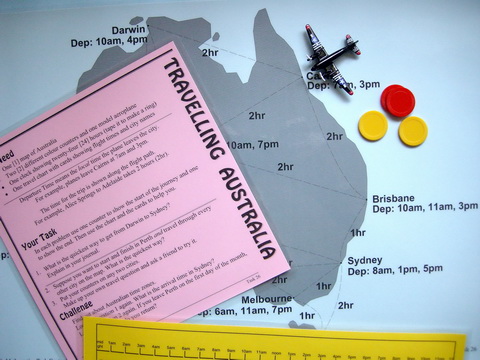
Travelling AustraliaTask 26 ... Years 2 - 8SummaryAnyone who has had to develop an itinerary involving flights between cities in sequence will be aware of the problems of matching departure and arrival times and problems of changing time zones. This task has a huge depth of investigation related to flying across the most fascinating country in the world. There are many challenges involving time, time difference, timetables and sequencing, as well as broader problem solving situations such as:
This cameo has a From The Classroom section which shows how a Year 7 teacher developed the task into a cross-curriculum project. It also has a contribution from a Year 6 teacher who independently devised a unit plan, also called Travelling Australia, which is based a driving through Australia. |
Materials
Content
|

IcebergA task is the tip of a learning iceberg. There is always more to a task than is recorded on the card. |
The card suggests directions for exploring the iceberg and they really don't end. Problems can be set by the teacher or created by the students. At a simple level just choosing a base city and asking the students to create the departure board for all flights from that city for the day, is a challenge which involves plenty of mathematics. More complex problems would be related to:
Problems related to other mathematics content and cross-curriculum work including plenty of geography and literacy can easily be an extension. Questions such as:
|
Whole Class InvestigationTasks are an invitation for two students to work like a mathematician. Tasks can also be modified to become whole class investigations which model how a mathematician works. |
To convert this task to a whole class lesson (or, perhaps, a whole class unit would be a richer way to think), one key element is the map. A3 size copies to share between pairs would work, but what about a large scale map in the centre of the carpet which the whole class can gather around. You could prepare this by projecting a tracing onto the floor and then marking out the shadow with masking tape. Alternatively, prepare it on a tough plastic (such as shade cloth), then the map can be easily rolled up and brought back as necessary. Students can bring their own small planes to use and the other items are easily reproducible. Begin the unit with the story shell that the class is a company about to set up an airline network across the country. As a team, develop a series of focus questions for the company (and of course a very marketable name) and roll on from there. Note: Between the mid 1990s and mid 2000s, two companies (Virgin Blue and Jet Star) did undertake exactly this challenge in Australia. At this stage, Travelling Australia does not have a matching lesson on Maths300. |
Is it in Maths With Attitude?Maths With Attitude is a set of hands-on learning kits available from Years 3-10 which structure the use of tasks and whole class investigations into a week by week planner. |
The Travelling Australia task is an integral part of:
|
MacKillop College
Gemma Headon |
Gemma was approached by Eva Larsson, a Year 6 teacher in Sweden, with the idea of stimulating mathematical learning by having their classes work on the same investigations and communicating with each other about them. Gemma started the ball rolling from her side with this extension of Travelling Australia which provides a great learning experience on both sides of the world. |
| Your task is to design a trip for a student in Class 6A in Sweden. They have never been to Australia and would like to see the sites. Your trip has to give directions using angles. You also need to tell them the distance they will be travelling (use the scale to help you).
Here is an example. Your friend has flown into Sydney International Airport. First stop is Sydney, then off to Mackay via Brisbane. Draw this journey on the map in pencil. Then fill in the information in the table. This will be used as your answer sheet. These instructions and the map were the first page of Gemma's investigation guide. The next page had the table and room for the students to tell a little about their most recommended Australian place to visit. As the examples below show, the students were keen to prepare this itinerary for their cyber-friends. The Gold Coast ranked high on the list of recommended visits, but others included Bathurst, Cairns, Geelong, Melbourne and Phillip Island. |

|

